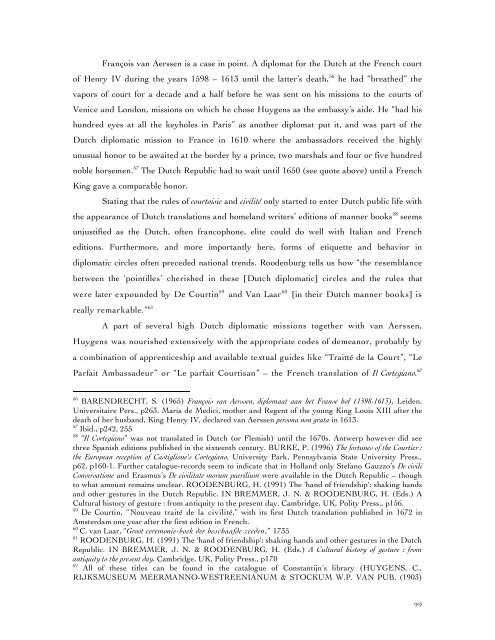Christiaan Huygens – A family affair - Proeven van Vroeger
Christiaan Huygens – A family affair - Proeven van Vroeger
Christiaan Huygens – A family affair - Proeven van Vroeger
You also want an ePaper? Increase the reach of your titles
YUMPU automatically turns print PDFs into web optimized ePapers that Google loves.
François <strong>van</strong> Aerssen is a case in point. A diplomat for the Dutch at the French court<br />
of Henry IV during the years 1598 <strong>–</strong> 1613 until the latter’s death, 56 he had “breathed” the<br />
vapors of court for a decade and a half before he was sent on his missions to the courts of<br />
Venice and London, missions on which he chose <strong>Huygens</strong> as the embassy’s aide. He “had his<br />
hundred eyes at all the keyholes in Paris” as another diplomat put it, and was part of the<br />
Dutch diplomatic mission to France in 1610 where the ambassadors received the highly<br />
unusual honor to be awaited at the border by a prince, two marshals and four or five hundred<br />
noble horsemen. 57 The Dutch Republic had to wait until 1650 (see quote above) until a French<br />
King gave a comparable honor.<br />
Stating that the rules of courtoisie and civilité only started to enter Dutch public life with<br />
the appearance of Dutch translations and homeland writers’ editions of manner books 58 seems<br />
unjustified as the Dutch, often francophone, elite could do well with Italian and French<br />
editions. Furthermore, and more importantly here, forms of etiquette and behavior in<br />
diplomatic circles often preceded national trends. Roodenburg tells us how “the resemblance<br />
between the ‘pointilles’ cherished in these [Dutch diplomatic] circles and the rules that<br />
were later expounded by De Courtin 59 and Van Laar 60 [in their Dutch manner books] is<br />
really remarkable.” 61<br />
A part of several high Dutch diplomatic missions together with <strong>van</strong> Aerssen,<br />
<strong>Huygens</strong> was nourished extensively with the appropriate codes of demeanor, probably by<br />
a combination of apprenticeship and available textual guides like “Traitté de la Court”, “Le<br />
Parfait Ambassadeur” or “Le parfait Courtisan” <strong>–</strong> the French translation of Il Cortegiano. 62<br />
56 BARENDRECHT, S. (1965) François <strong>van</strong> Aerssen, diplomaat aan het Franse hof (1598-1613), Leiden,<br />
Universitaire Pers., p263. Maria de Medici, mother and Regent of the young King Louis XIII after the<br />
death of her husband, King Henry IV, declared <strong>van</strong> Aerssen persona non grata in 1613.<br />
57 Ibid., p242, 255<br />
58 “Il Cortegiano” was not translated in Dutch (or Flemish) until the 1670s. Antwerp however did see<br />
three Spanish editions published in the sixteenth century. BURKE, P. (1996) The fortunes of the Courtier :<br />
the European reception of Castiglione's Cortegiano, University Park, Pennsyl<strong>van</strong>ia State University Press.,<br />
p62, p160-1. Further catalogue-records seem to indicate that in Holland only Stefano Gauzzo’s De civili<br />
Conversatione and Erasmus’s De civilitate morum puerilium were available in the Dutch Republic <strong>–</strong> though<br />
to what amount remains unclear. ROODENBURG, H. (1991) The 'hand of friendship': shaking hands<br />
and other gestures in the Dutch Republic. IN BREMMER, J. N. & ROODENBURG, H. (Eds.) A<br />
Cultural history of gesture : from antiquity to the present day. Cambridge, UK, Polity Press., p156.<br />
59 De Courtin, “Nouveau traité de la civilité,” with its first Dutch translation published in 1672 in<br />
Amsterdam one year after the first edition in French.<br />
60 C. <strong>van</strong> Laar, “Groot ceremonie-boek der beschaafde zeeden,” 1735<br />
61 ROODENBURG, H. (1991) The 'hand of friendship': shaking hands and other gestures in the Dutch<br />
Republic. IN BREMMER, J. N. & ROODENBURG, H. (Eds.) A Cultural history of gesture : from<br />
antiquity to the present day. Cambridge, UK, Polity Press., p170<br />
62 All of these titles can be found in the catalogue of Constantijn’s library (HUYGENS, C.,<br />
RIJKSMUSEUM MEERMANNO-WESTREENIANUM & STOCKUM W.P. VAN PUB. (1903)<br />
22


